
Apr
KIU Western Campus Organizes Successful Cervical Cancer Run
April 16, 2024, 11:16 am
 Collins Kakwezi
Collins Kakwezi

By Isaac Akugizibwe
KIU, Main Campus - The seventh day of January is one many Japanese will forever wish to forget yet memorizing it is paramount. This is the day in the year 1989 when their longest-serving emperor and monarch Hirohito breathed his last.
According to Encyclopaedia Britannica, Kinjō, Michinomiya Hirohito, posthumous name Shōwa was born April 29, 1901, at the Aoyama Palace in Tokyo, Japan, and died January 7, 1989, in Tokyo.
He served as emperor of Japan from 1926 until his death in 1989.
He was educated at the Peers’ School and at the Crown Prince’s Institute. Early in life, he developed an interest in marine biology, on which he later wrote several books.
In 1921 he visited Europe, becoming the first Japanese crown prince to travel abroad. After his return, he was named prince regent when his father retired because of mental illness.
In 1924 Hirohito married the princess Nagako Kuni. Hirohito became emperor of Japan on December 25, 1926, following the death of his father. His reign was designated Shōwa (“Bright Peace,” or “Enlightened Harmony”).
There still remains considerable debate among historians at KIU and elsewhere globally about the role Hirohito played during Japan’s militaristic period from the early 1930s to 1945, the end of World War II. Many assert that he had grave misgivings about war with the United States and was opposed to Japan’s alliance with Germany and Italy (the Axis Powers) but that he was constrained to go along with the militarists who increasingly came to dominate the armed forces and the government.
Others claim that Hirohito was actively involved in the planning of Japan’s expansionist policies from the Japanese invasion of Manchuria (now northeastern China) in 1931 to the end of the war. Still, others argue that the truth lies somewhere between those two interpretations.
Under the country’s new constitution, drafted by U.S. occupation authorities in 1946 and in effect from 1947, Japan became a constitutional monarchy. Sovereignty resided in the people—not in the emperor, whose powers were severely curtailed. The emperor was designated the “symbol of the state and of the unity of the people.”
In an effort to bring the imperial family closer to the people, Hirohito began to make numerous public appearances and permitted the publication of pictures and stories of his personal and family life. Those actions increased Hirohito’s popularity and helped preserve the Japanese imperial system.
In 1959 his oldest son, Crown Prince Akihito, married a commoner, Shōda Michiko, breaking a 1,500-year tradition. In 1971 Hirohito broke another tradition when he toured Europe and became the first reigning Japanese monarch to visit abroad. In 1975 he made a state visit to the United States, which included a highly publicized day trip to Disneyland in southern California and a meeting with Pres. Richard M. Nixon, the first time a Japanese emperor and a U.S. president had met. Upon his death in 1989, Hirohito was succeeded as emperor by Akihito.
Kampala International University,
Box 20000, Ggaba Road, Kansanga, Kampala